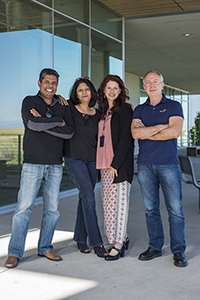 Researchers at the University of California, Merced, won a $5 million grant from the National Science Foundation (NSF) to study how biological matter like proteins or cells come together to perform specific tasks, effectively behaving as machines.
Researchers at the University of California, Merced, won a $5 million grant from the National Science Foundation (NSF) to study how biological matter like proteins or cells come together to perform specific tasks, effectively behaving as machines.
The research — funded over five years through the NSF’s Centers of Research Excellence in Science and Technology (CREST) program — could help researchers design and develop innovations ranging from designer cells and tissue to novel diagnostic and therapeutic devices.
The grant allows UC Merced researchers to create the new CREST Center for Cellular and Biomolecular Machines (CCBM), which brings together more than a dozen faculty members from multiple units across campus, including bioengineering, physics, chemistry and chemical biology, materials science and engineering.
Bioengineering Professor Victor Muñoz, with the School of Engineering, and physics Professor Ajay Gopinathan, with the School of Natural Sciences, will serve as co-directors of the center, overseeing all operations. Professors Kara McCloskey and Sayantani Ghosh will lead the graduate and undergraduate education and outreach efforts, respectively.
“Our vision for the CCBM is to be nationally and internationally recognized for cutting-edge interdisciplinary research on functional multi-scale biomolecular and cellular assemblies and to be a model for integrated research, education and outreach,” Gopinathan and Muñoz said in a joint statement. “Through focused efforts to encourage participation among underrepresented students from the San Joaquin Valley and beyond, we envision developing a pipeline for a highly qualified science, technology, engineering and math (STEM) workforce and producing high-caliber, diverse trainees at all levels who can spur growth in California’s San Joaquin Valley.”
The grant, which is given to minority-serving institutions, will fund new research instrumentation and computational resources that further empower the research agenda at UC Merced, Muñoz and Gopinathan said. New personnel, including administrative staff and project scientists, will also be recruited to fulfill CCBM’s research and training mission.
Muñoz and Gopinathan won the highly competitive grant on their first application.
“This award is another milestone in the development of UC Merced, and is the third multimillion dollar award the campus has received this year,” School of Engineering Dean Mark Matsumoto said. “Congratulations to professors Muñoz and Gopinathan for their collaboration in putting forward this outstanding program. I am very proud of the achievements of these excellent faculty members.”
The center is built around three research emphases:
- biomolecular machines, which focuses on designing and characterizing nanoscale instruments based on protein molecules;
- macromolecular assemblies and hybrid devices that combine the benefits of synthetic and biological materials for functional devices; and
- cellular and multicellular systems such as tissue and bacterial swarms.
Each emphasis will have its own group of researchers, from undergraduates to faculty members. An overarching theme is the investigation of the principles that guide the assembly and cooperation of molecules, cells and groups of cells to produce key biological functions, all in the hope of eventually being able to fully engineer cells and tissues.
“How each cell decides what it will become, how each one knows where to migrate and how cells know when they have reached functional capacity — it’s an amazing example of self-organization,” Muñoz said.
“If you understand the engineering principles, this work has many different applications,” Gopinathan said. “The center is a way to accelerate everyone’s research.”
UC Merced is particularly suited to the challenge of this new center many of the faculty members already work at the interface of the physical and biological sciences and engineering. The center’s design also aligns with the institution’s plans for further growth in the area of adaptive and functional materials.
CCBM will offer training opportunities for graduate and undergraduate students — including team-based research during the school year; summer internships with other institutions such as UC Santa Barbara, the Lawrence Berkeley National Laboratory and the California Institute for Quantitative Biosciences; on-campus research internship opportunities for California State University students; and outreach programs directed at local high school campuses. CCBM will also host an entrepreneurial scholars program in which collaborations will lead to commercialization opportunities for students’ research.
“This is an outstanding achievement for our campus, and an incredible opportunity for undergraduate and graduate students,” School of Natural Sciences Dean Juan Meza said. “I look forward to the future of this center, which will bring people together from across campus to enhance the stellar research already taking place here.”
Congressman Jim Costa, D-Fresno, who works to increase the NSF investment in UC Merced research, offered his congratulations.
“This grant funding from the National Science Foundation further proves that UC Merced is on its way to becoming one of the top research universities in the country,” Costa said. “The innovation we witness from the professors and students on the campus is truly remarkable, and these funds will enable them to continue making strides in cutting-edge research that ultimately provides lasting benefits to our region, state and the entire nation.”
By Lorena Anderson, University Communications

